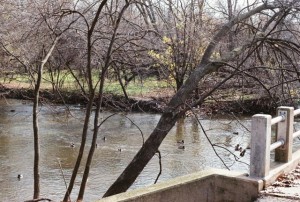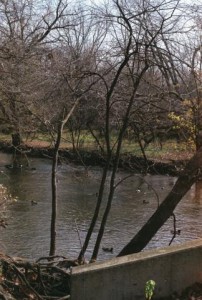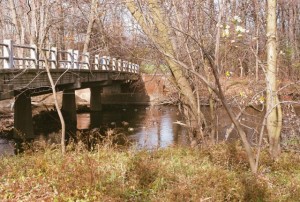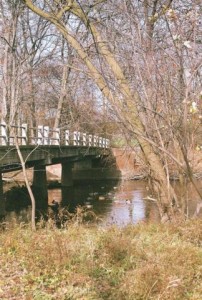Do you buy old film cameras with questionable light metering systems? This is my solution to testing my old cameras and their exposures.
This is my solution to the old camera light metering problem.
Saturday, November 11, 2011 I went to Costco to shop and have film developed. While they developed the film I went to a Cook County Forest Preserve on Lehigh in Edgebrook, IL and learned a huge amount about testing cameras. It happend all of a sudden.
I had recently purchased a used Gossen Digisix light meter but I had unresolved problems.
- Testing an old camera with two rolls of film is too expensive. One roll for the camera’s light meter and one roll for the Gossen Digisix test costs too much money. And I’ll waste a lot of shots that I’ll never get back.
- If I test the light meter of a camera vs the Gossen Digisix on the same film roll, how will I know what technique I used for each test?
- Even testing an old film camera I hope to get some useable photos in the process. I’m not just testing a camera, I’m hoping to take a few good photos.
- I also want to use the “Sunny 16” rule to test my cameras.
I had tried a previous method for testing a light meter outdoors but was disappointed with my logic. But this Saturday it came to me.
Take two photos of every scene when testing a camera. Landscape and then portrait.
- Find a scene to test your camera’s light meter.
- Landscape – Use landscape format to test the camera’s light meter.
- Portrait – Use portrait format to test a Gossen Digisix light metered exposure.
What could be simpler? On your roll of film, whenever you see two photos of the same thing, you’ll know its an exposure test. All my photos are normally at F16 aperture. More on that later.
Sunny 16 Testing
If you’re feeling adventurous and just want to test the camera with the Sunny 16 rule, just take one photo of something on a bright sunny day. Here’s my plain English description of the Sunny 16 rule.
On a sunny day outside you can test a camera without a light meter. This is best done with ASA 100 film or perhaps ASA 400 film.
- This only works shooting outdoors on a sunny day.
- Set your aperture to F16.
- Set your shutter speed to “match” your film speed. If you are shooting with ASA 100 film, set your shutter speed to 1/100. If you are shooting with ASA 400 film, set your shutter speed to 1/500 (it’s the best you can do).
I only take single photos on a test roll when using the “Sunny 16” rule.
Two photos of the same scene in landscape and portrait tells me its a camera light meter vs. Gossen Digisix test. A single photo of a scene tells me it was a Sunny 16 test.
Single shots for sunny 16, two shot tests for every angle (lateral is for camera’s light meter, vertical is for Gossen Digisix), shoot F16 and then mix the rest, always using the same aperture.
Photos of a Lifetime
If you find some photos of a lifetime and you’re testing a camera, you should pull out your backup camera that’s dependable and tested. Don’t be rigid on this. Take a digital camera with you if you can depend on it always or toss your most dependable film camera into a bag (my five dollar Canon 130u with its zoom lens might be my choice, with a fresh battery).
In 1953, driving to a fishing trip with her husband, Virginia Schau became the first woman to win a Pulitzer Prize for her photo. She was using an inexpensive Kodak camera. She photographed a truck hanging off an expressway bridge with a man hanging on to the truck for dear life. 
Virginia Schau, amateur
Rescue on Pit River Bridge – 1954 winner.
Other Light Meter Testing Methods
Read About.com’s Gray Card method for testing a light meter.
Ollinger has a wonderful website on old light meters. He also has a fine article by Peter Moore that’s rather scientific on testing film camera light meters.
My First Test Results with my Olympus OM-1n
Two poorly exposed rolls of film (my Zenit-E and my Olympus OM-1n) compelled me to purchase a Gossen Digisix like a real photographer.
I’ll show my results for testing film camera light meters here and at my Olympus OM-1n page when the testing is done.
My second roll of film through my Olympus OM-1n was my first camera meter vs. Gossen Digisix test. Remember the method:
- Landscape for camera meter.
- Portrait for Gossen Digisix.
Most of the photos were taken on a partly cloudy day at F16 aperture. I’d have to say the test was inconclusive. A 50/50 horse race as to which technique was better.
In the two photos below, the photo below looks closer to the scene as I remember it. Better exposure with the Gossen Digisix on the right.
But this photo of ducks under a bridge came out totally opposite of what I expected. The photo on the left using the Olympus OM-1n camera meter looks better exposed than the Gossen Digisix metering on the right. Quite frankly, both look a bit washed out.
I’m still glad I purchased the Gossen Digisix. But in my initial testing of the Olympus OM-1n, there was no clear winner between the camera’s light meter (with a non-Mercury battery) and using a Gossen Digisix light meter.
Thanks for visiting What is a Film Camera today.




